This season, Aberdeen have had a very fruitful campaign in the Scottish Premiership. Derek McInnes has guided his side up to fourth in the table and pushing for a top-three finish. The Dons are just one point behind Motherwell in third and vying for a Europa League spot before the league was postponed. McInnes and his team will certainly want to finish the eight games remaining as they will look to try and claim a European competition status and build from this season’s disappointing exit from the Europa League qualification round.
Spearheading Aberdeen’s good season and push for a top-three finish was 23-year-old striker Sam Cosgrove. The English striker was spotted by McInnes and his staff as he played for Carlisle United reserves where the Aberdeen manager believed he had the attributes and potential to fill the void left by the departure of Adam Rooney. The Dons signed the striker in 2018 where he exceeded expectations in his first full season in Scotland scoring 21 goals in all competitions.
Cosgrove has continued his impressive goal-scoring run this season where he has netted 23 goals in all competitions. The striker’s performances have alerted and sparked the interest of many English clubs, namely from the Championship who are keen to prise the Dons forward away from Pittodrie turf. In this tactical analysis in the form of a scout report, we will examine how Sam Cosgrove has become a key player for Aberdeen. The report will also outline key attributes that make the 23-year-old such a prolific scorer this season.
Attacking tendencies
The Beverley-born striker is Aberdeen’s leading goal scorer with 11 goals and ranks 6th highest in the league. The former Carlisle United player is an old-school number nine, standing at 188cm tall, he is big and physical and is a handful for opposition defenders where he tends to bully them with his large dominating physique.
Cosgrove uses these physical attributes to his advantage where he is a real aerial threat in the box. The Dons forward competes in 14.36 aerial duels p/90 with a 49% success rate, making him one of the best players in the air in the league. As a result of his aerial superiority, he causes problems in the opposition’s box and scores a lot of headed goals. The English striker thrives when crosses are floated into the box for him to attack in the air.
However, he does not rely on just on his height and strength, he picks up clever positions inside the box where his teammates can pick him out with a cross, while his positioning also increases his chances of scoring.
Cosgrove is not static and will look to come from a central position and before his teammate sets himself and looks up to deliver the cross the Dons forward will peel back to the far post. When the ball is delivered, the forward from this position has more time to anticipate the flight of the ball and generate a significant run-up to attack the ball in the air.
This positioning was evident when he scored against Celtic in December, as Aberdeen had progressed the ball on the right wing into a crossing position. Sensing the ball will be crossed in, Cosgrove moves from his starting position (red circle) and peels to the back post but keeps a separation from Celtic’s defensive line.
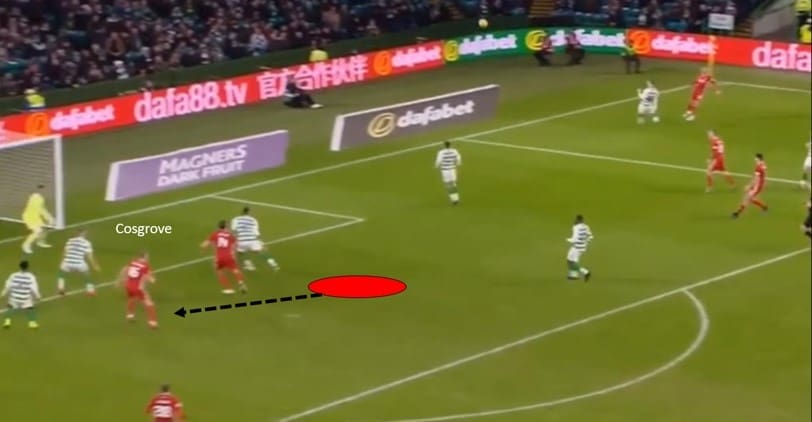
As the ball is crossed in, he moves into the space between Kristoffer Ajer and Jeremie Frimpong and in this position, he is able to anticipate the flight of the ball and by maintaining separation from the Celtic defenders, he is able to generate a good run and leap to attack the ball and head it past a helpless Fraser Foster in goal.
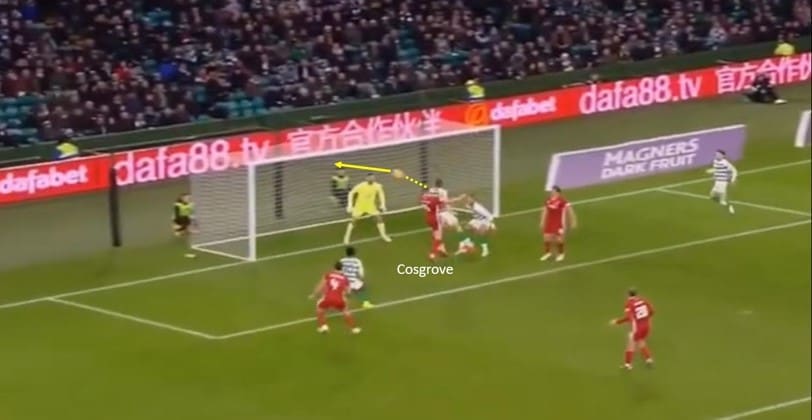
Although his aerial ability is clearly a big strength in the box, he likes to score not just with his head as he varies his play to become unpredictable in the box. He has a great knack of finding pockets of space in and around the box to get shots off and score goals. The forward is a poacher with great movement, anticipation, and a fast thought process to find favourable areas in the box in which to score from. This is evident as the striker has an xG per shot of 0.17 which is one of the best rates in the league.
Cosgrove’s clever movement inside the box is shown below in the game against St. Mirren, as Aberdeen again progress the ball down the right and look to cross the ball into the area. St. Mirren have bodies back and hold a deep defensive line in the box, and coupled with this, there are Aberdeen players anticipating the cross and have blocked the spaces in between the St. Mirren defenders.
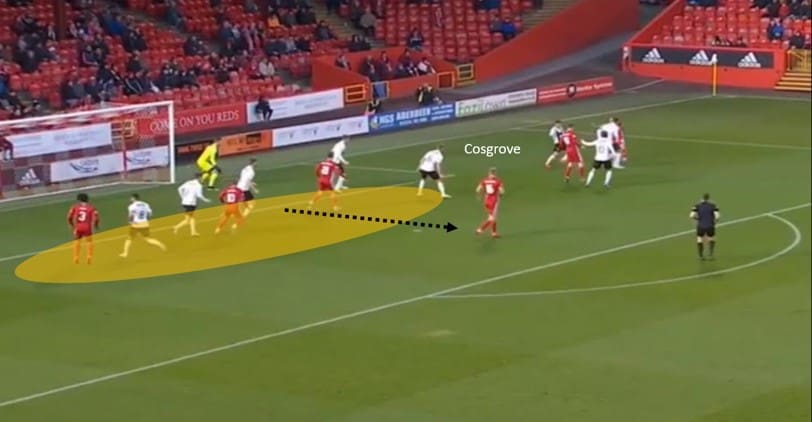
There is a lack of space around the six-yard area in front of the goal, Cosgrove’s speed of thought recognises this and he identifies the space by dropping to the edge of the box for a cut-back which would give him more time and space to get a shot off on goal.
The cross is instead floated into the packed area rather than into the Englishman in space at the edge of the box. The ball in however does not beat the first St. Mirren defender who heads the ball away. Fortunately for Cosgrove, the defender clears straight to his feet, where he controls the ball and has the time to compose himself before finishing into the top corner.
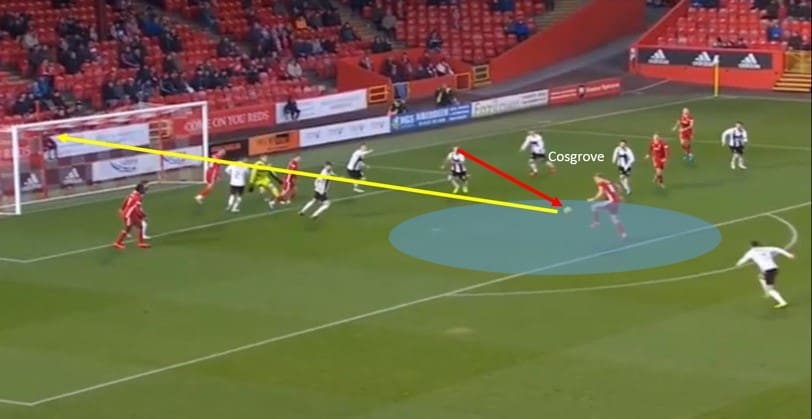
Movement in behind
A forward will thrive and create problems for opposition defenders if they are unpredictable – as mentioned above, the Aberdeen forward likes to vary his play and add an unpredictable nature to his game. One area Cosgrove has worked on this year to provide variety to his game is attacking the space in behind.
When Aberdeen win the ball back and look to transition on the counter-attack and an opposition defender is up against Cosgrove, they will naturally press onto the striker expecting him to come towards the ball and get the ball into feet due to his physical attributes, so they will look to engage in a duel. This leaves space in behind but the Dons striker cleverly shapes like he is looking for the ball into feet, lulling the defender into a false sense of security.
As soon as the defender looks to engage the striker, he identifies where space has opened up in the half-space from their action. He attacks the space and looks for the ball in behind, which you can see he does below against Kilmarnock where he has a burst of pace and strength to get away from the opposition defenders, with the move ending in him getting a shot on goal.
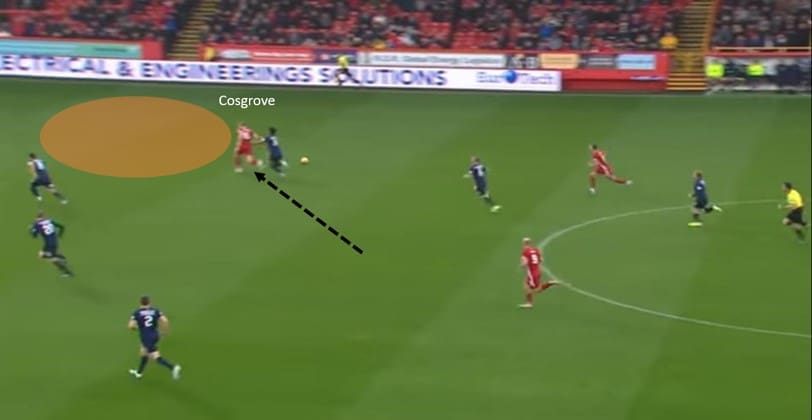
Cosgrove provides a variation of this movement in behind against Motherwell, but this time the striker does not look to drop and draw the defender out of position before attacking the space left behind. Instead, he stays on high on the defensive line but positions himself between the two central defenders. This engages both defenders, pulling them in narrow towards him but in doing so, it opens up space in the half-spaces.
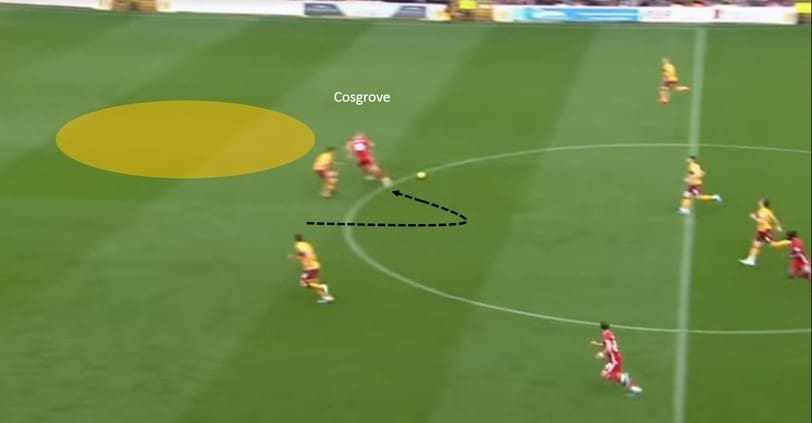
The English striker waits until the ball is progressed into Motherwell’s half and then makes run from the central position and spins out to the left half-space. The left centre-back has planted both his feet, not expecting the movement and Cosgrove runs into the space and is played in behind.
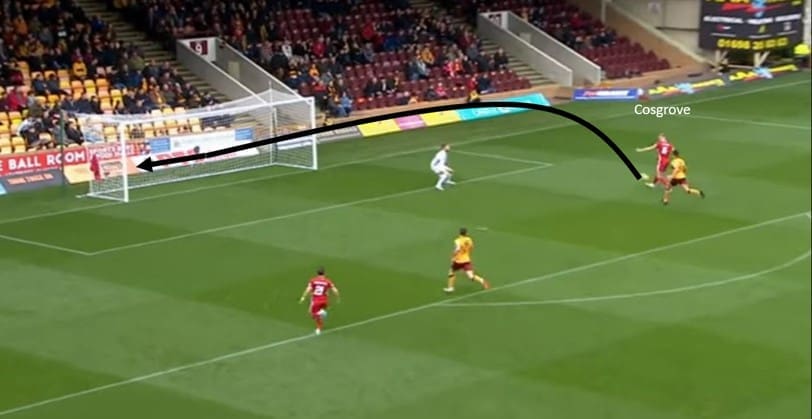
The Englishman’s well-timed unpredictable run has given him a 5-10 yard headstart in which he can bear down on goal having the time, space, and composure to chip over Mark Gillespie.
Cosgrove under the guidance of McInnes is always improving his ability to create chances to score goals with his clever unpredictable movement inside and outside of the box where he scores an average of 0.48 goals per game. Overall, the striker has contributed to 30% of Aberdeen’s total goals in the league which shows how important he is and how much the team relies on him to produce goals.
Goal-scoring drought
With the reliance and pressure put on Cosgrove, coupled with the fact he had a prolific goalscoring record, it was inevitable that there would be a drop-off in his goal-scoring levels. The winter break proved to be the catalyst for his goal-scoring level to drop and it dropped significantly. The Aberdeen striker scored all of his 11 goals in the league in the first half of the season, taking into account goals in all competitions where he scored 20 of his 23 goals before the winter break.
The three goals he did score this calendar year were all from penalties in the Scottish Cup, he has produced no goals in the league since his goal against Celtic in December. Cosgrove is like a lot of strikers: a confidence player, and once a forward goes on a run of not scoring, it starts to put even more pressure on the player to score which affects their performance levels.
This is certainly a significant factor psychosocially as to why the Aberdeen striker has failed to produce goals but digging deeper in the analysis, there are a few glaring reasons why he has not been hitting the back of the net more regularly this calendar year.
One of the main reasons why Cosgrove has failed to score from open play after the winter break is down to his supply. Aberdeen is the fourth-worst team in the league in terms of their xG: 30.9, meaning they are poor at creating goal-scoring opportunities. The Aberdeen forward is limited to scraps and has to work hard to create chances for himself.
The striker makes movements into dangerous areas but his teammates are supplying him with poor passes or they are electing to ignore the run, the latter being evident in the game against Rangers where Cosgrove identifies the space and makes a good run in behind the defender engaging Jon Gallagher.
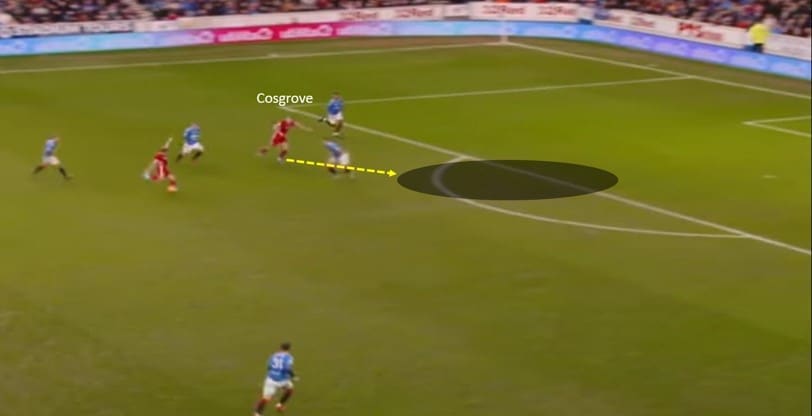
But Gallagher, instead of playing the striker in on goal, elects to take on a long-range shot on goal which does not trouble Allan McGregor in the Rangers net, wasting a glorious chance to set up the Aberdeen striker.
Another area that highlights the lack of supply Cosgrove gets is his 78 touches in the penalty area this season where the likes of Scott Arfield and Celtic’s full-back Jeremie Frimpong have had more touches in the penalty area. Even the greatest strikers need good supply into them for them to convert the chances into goals.
The Aberdeen strikers teammates are not supplying enough of the ball for him to convert as they are not creating decent goal-scoring opportunities even through his best efforts, as we can see below. Aberdeen wins back the ball high up the pitch against St. Mirren through Niall McGinn on the left. Cosgrove does well to get goal-side of his man as he looks to attack the oceans of space in the box.
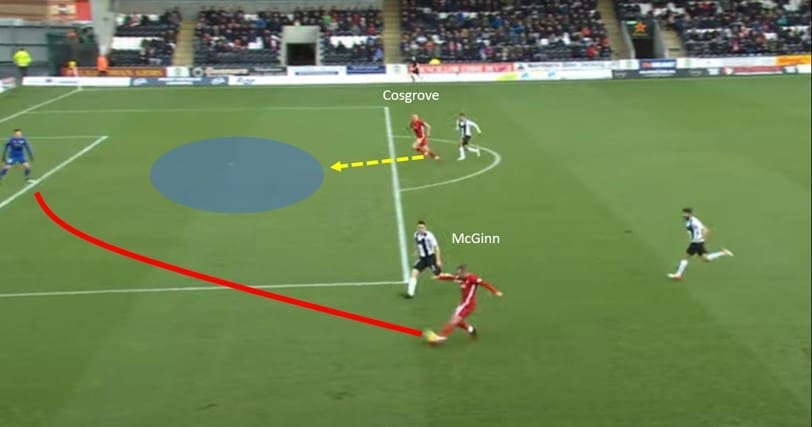
All McGinn has to do is cross the ball into the area for Cosgrove who is now free but instead, the Dons winger crosses the ball straight into the keeper’s hands, resulting in frustration for the forward who surely would have converted from six yards out but instead, the supply to him was very poor.
Another reason why Cosgrove is failing to score from open play this calendar year is due to his shot volume and shot location. The Aberdeen striker has attempted just seven shots on goal in the seven games he played in the league after the winter break. The shot volume can be closely tied to the fact that he is not getting good quality supply in which he can take a shot on goal.
However, the Aberdeen striker since the turn of the year in the league has an xG value of just 1.01 from his 7 shots on goal, which means he is shooting from poor shot locations like we can see below against St. Johnstone in February. Cosgrove looks to head towards goal but is closed down by an opposition defender who forces him from the central zone at the edge of the box out to the right.
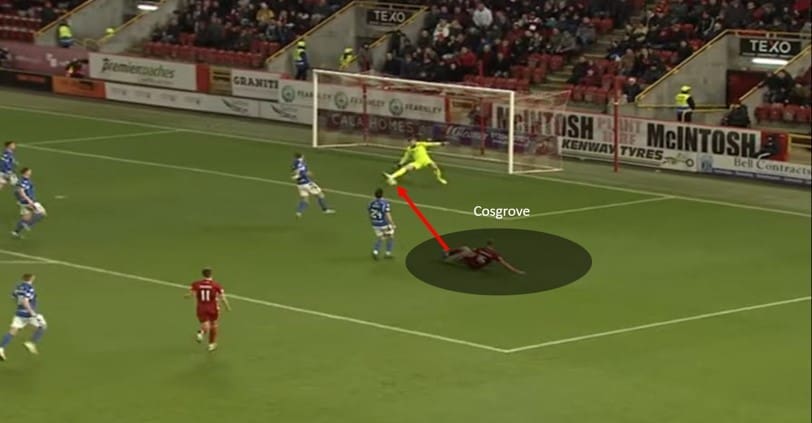
The Aberdeen striker is reluctant to pass the ball to his teammates and tries to push the ball past the defender out to the right, but this action makes the angle of the shot harder to score from. Cosgrove in trying to generate power for the shot, while also running at full speed, loses balance and the shot is easy for the keeper to save.
With the limiting number of chances being created for the striker, he seems to be a frustrated figure where he is trying shots from poor locations in an attempt to break his goal drought. With such poor limiting supply, it is hard for the former Carlisle United striker and thus the main reason for his drop in goal-scoring form.
Areas for improvement
One area that Cosgrove should look to improve on is working on setting up his teammates with assists. The big striker has only one assist all season and an xA rate of just 1.37 which means he tends not to look to contribute to the creation of chances for his teammates. He tends to have tunnel vision and just wants to score goals when he is in a prolific goal-scoring streak which is great for Aberdeen, but when the goals dry up, he is not offering anything in terms of goal contribution.
In the pursuit of scoring more goals, Cosgrove takes shots from difficult angles where instead a pass to a teammate in a better position is available, like in the game against Kilmarnock. The Aberdeen striker has progressed the ball just inside the area and is surrounded by two defenders.
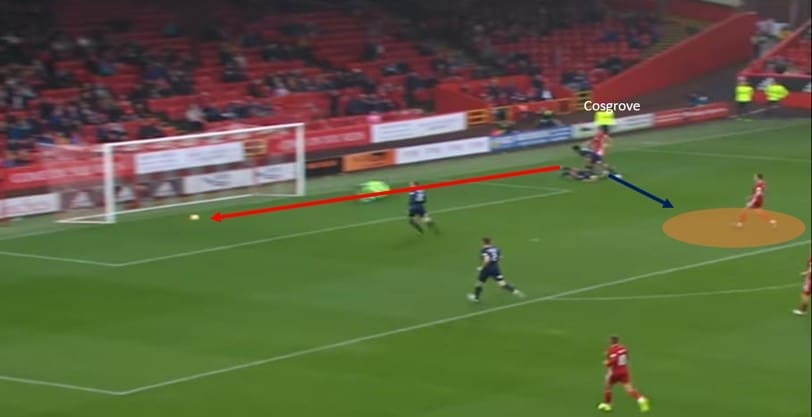
Coupled with this, the shot angle on goal is very acute and difficult to score from but Cosgrove elects to take on the shot anyway. The better option would be to cut the ball back to his teammate who is free at the edge of the box and has a clear direct shot on goal, but he has only one thought and that is shoot, so on this occasion, his decision-making is poor.
Another area Cosgrove should look to improve is his ball retention and his ball control. The Dons striker loses the ball 17.08 times p/90 which shows ball retention is an area he needs to work on going forward. The big area that lets him down is his ball control where his touch can be quite loose at times, coughing up possession to the opposition. His poor ball control can let him down at crucial times like in the image below against Rangers, where the big striker is bearing down on goal and looks like he will break his goal-scoring drought.
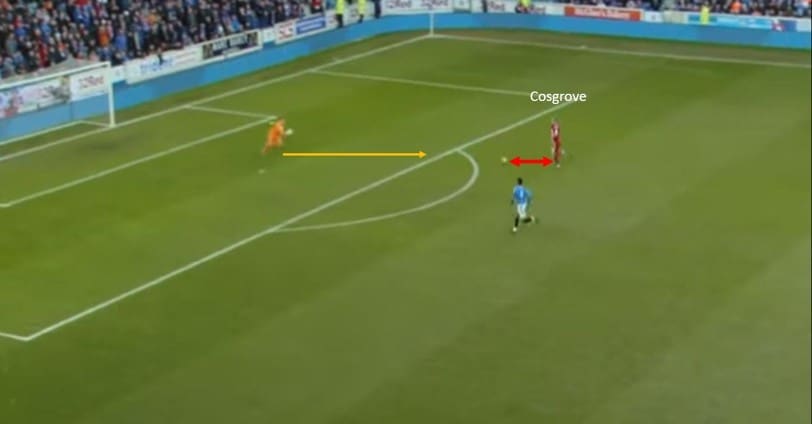
However, at the crucial point, he takes a heavy touch which triggers Allan McGregor to come out and claim the ball. The ball runs away from the big striker due to this poor touch and the Rangers keeper can easily claim the ball – a huge opportunity missed, and something the forward must work on.
Conclusion
Sam Cosgrove is a big physical striker who is a prolific scorer where he has managed to score 44 goals in all competition in the last two seasons. The forward does not rely just on his height with which he has great anticipation, movement, and a great knack to find space in which he can score from in or around the box. The big striker has struggled to score of late and that is maybe down to McInnes’ tactics to stay defensively sound which isolates Cosgrove and thus he lacks supply, as shown in the analysis.
McInnes can take real credit by taking a chance on a striker in the Carlisle reserves and developing into the epitome of a number nine. Aberdeen has found in Cosgrove a goal scorer which is a huge asset to their team, and which has sparked the interest of many teams south of the border. The forward is still relatively young and if he continues on this trajectory, Aberdeen will be offered a fee to prize him away they cannot refuse.





Comments